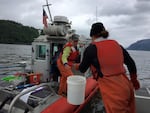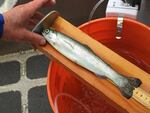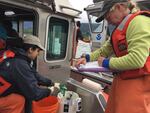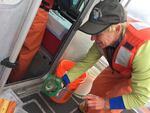
A blood sample allows researchers to test for a growth hormone released by the liver after a fish eats.
Cassandra Profita/EarthFix
On a research boat on the Columbia River, Laurie Weitkamp with the National Oceanic and Atmospheric Administration grabs two buckets filled with water and about a dozen young salmon and steelhead.
“Ooh, we got some steelies!” she says.

Research fisheries biologist Laurie Weitkamp with National Oceanic and Atmospheric Administration collects juvenile salmon from the Columbia River.
Cassandra Profita/EarthFix
By stretching a net across the river below Bonneville Dam, researchers are intercepting the fish swimming toward the ocean to see what they’ve been eating.
What they really want to know is whether the fish are eating bugs that came from marshes restored for their benefit. That’s key to proving habitat restoration is helping the fish grow and survive.
Federal agencies have spent millions of dollars restoring salmon habitat on the lower Columbia River as part of a massive effort to save salmon from the impacts of hydroelectric dams.
In the Columbia Basin, 13 species of threatened and endangered salmon and steelhead are navigating a river system loaded with dams.
The federal plan to help them has been challenged and rejected in court five times in more than 20 years. In that plan, the agencies told the court that restoring marshes in the estuary will help save threatened and endangered fish. The court’s response has been along the lines of: Oh yeah? Prove it.
That’s where Weitkamp comes in, with an elaborate research project funded by the U.S. Army Corps of Engineers.

A total of 13 species of salmon and steelhead in the Columbia River Basin are listed as threatened or endangered.
Cassandra Profita/EarthFix
Hormones and stable isotopes
After measuring and labeling the fish, Weitkamp hands them to Meredith Journey, who uses a syringe to take a blood sample.
She’ll test the blood for a growth hormone released by the liver that will tell them whether the fish has recently been eating.

Researchers sample and label juvenile salmon in the Columbia River to learn more about how they're using restored marsh habitat.
Cassandra Profita/EarthFix
From there, the fish go to Angie Munguia who clips their fins for genetic testing and puts them in a cooler.
“We try to put them on ice as soon as possible to try to stop the digestive process in the stomach," she said. "The more it digests, the harder it is to ID prey in the stomach.”
Later, the fish will get sliced up and analyzed at what Munguia calls "cutting parties."
Looking inside the stomach will tell Munguia what bugs the fish have been eating, but her work doesn’t stop there. With further analysis, she can also tell what plants those bugs were eating before they became fish food.
Together, Weitkamp says, these tests help build the government’s case that restored marshes are feeding fish and helping them survive.
“Generally, the bigger you are, the fewer predators can eat you," she said. "So big fish generally have higher survival when there are [more] predators around than really small fish.”
While Weitkamp is catching salmon and looking in their stomachs, other researchers are studying the bugs coming out of restored marshes. Their goal is to connect the dots between bugs in the marsh and bugs in the fish.
“Then we can kind of put it together, but it’s tough,” Weitkamp said.

Researchers Angie Munguia, left, and Laurie Weitkamp collect and sample juvenile salmon from the lower Columbia River.
Cassandra Profita/EarthFix
More certainty
The question of just how much habitat restoration improves salmon survival has become more and more pressing as judges have repeatedly rejected the federal plan for protecting salmon from dams.
In his ruling last year, federal District Court Judge Michael Simon called the uncertainty of habitat restoration a "significant deficiency" in the government's plan. He said the agencies should look at other options, like spilling more water over dams or removing some dams altogether.

Federal agencies keep track of salmon migrating through the Columbia River Basin to see how many are surviving to adulthood.
Cassandra Profita/EarthFix
Michael Tehan, assistant regional administrator with NOAA Fisheries, said it's clear the judge wants more certainty about how much benefit the salmon can get from habitat restoration. What's not clear is whether the agencies can deliver.
“Through all these court rulings, the judge has been asking the question: We want to know exactly how much," he said. "The science just doesn't allow you to pin it down with that kind of certainty."
That raises questions about whether the agencies need more science or a different strategy for helping salmon.
"There are some folks who are questioning: Why are you continuing to pursue habitat projects if you're not getting credit from the courts?" Tehan said.
Will the science satisfy the court?
Mike Langsley, a fish biologist with the Corps of Engineers, says the agencies have made significant improvements in salmon survival through the dams themselves. Fish passage is up to 98 percent in some places.
That leaves them looking at where else they help salmon survive. Breaching dikes and opening up floodplains seems like it should help.
"Because we know historically that’s how it looked," he said. "You’ve got a place salmon can’t access. You open it up so they can access it. So how do you figure out whether that’s good or bad?"

NOAA research fisheries biologist Laurie Weitkamp measures juvenile salmon on a research boat on the Columbia River.
Cassandra Profita/EarthFix
He said science can show the fish are using the habitat and eating the bugs it produces, but that might not be enough to prove more salmon are surviving to adulthood as a result.
"They feed. They grow. Just being in there maybe is good," he said, "but it’s a very difficult thing to say that’s going to increase smolt-to-adult return rates by some percentage."
Job security
Weitkamp says there’s still a lot we don’t know about how to help salmon survive.
"I mean, each salmon species makes its life slightly differently, and it's really fascinating to try to uncover: What is their strategy? What are they thinking?" she said.
For her, the need to save imperiled fish from dams in the face of a seemingly never-ending lawsuit means she'll always have more questions to answer and more work to do.
In other words, she said, "job security."
